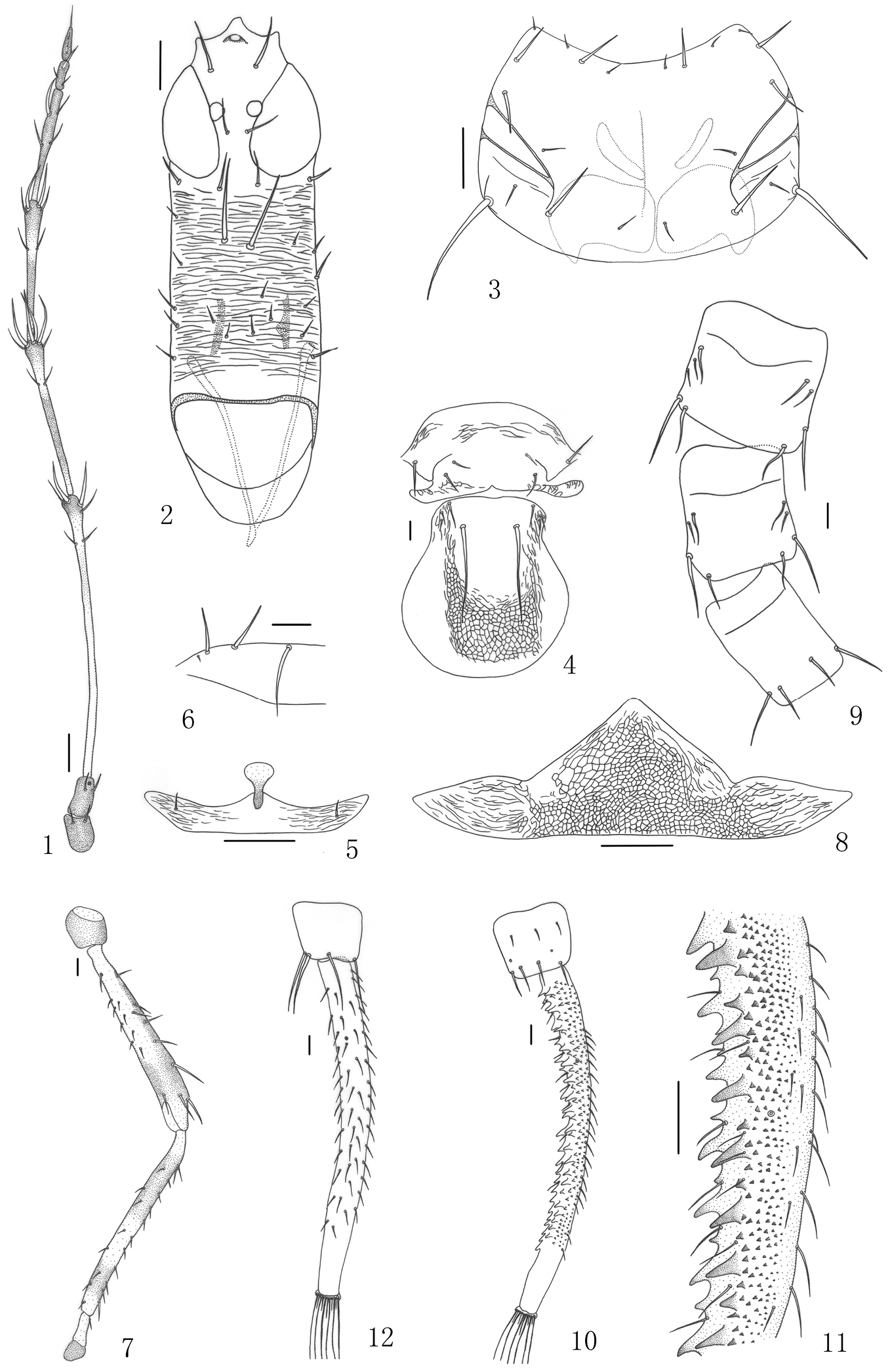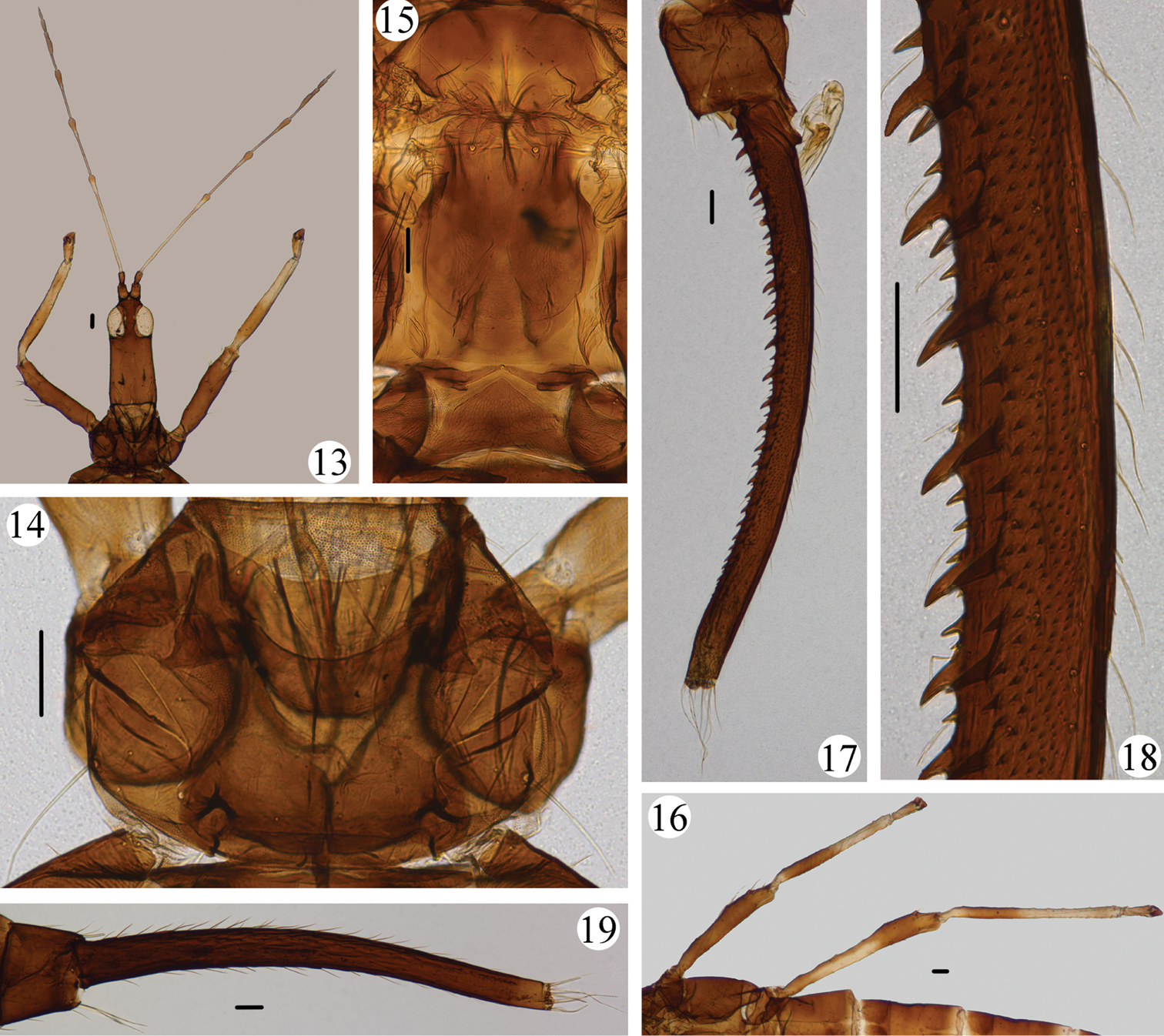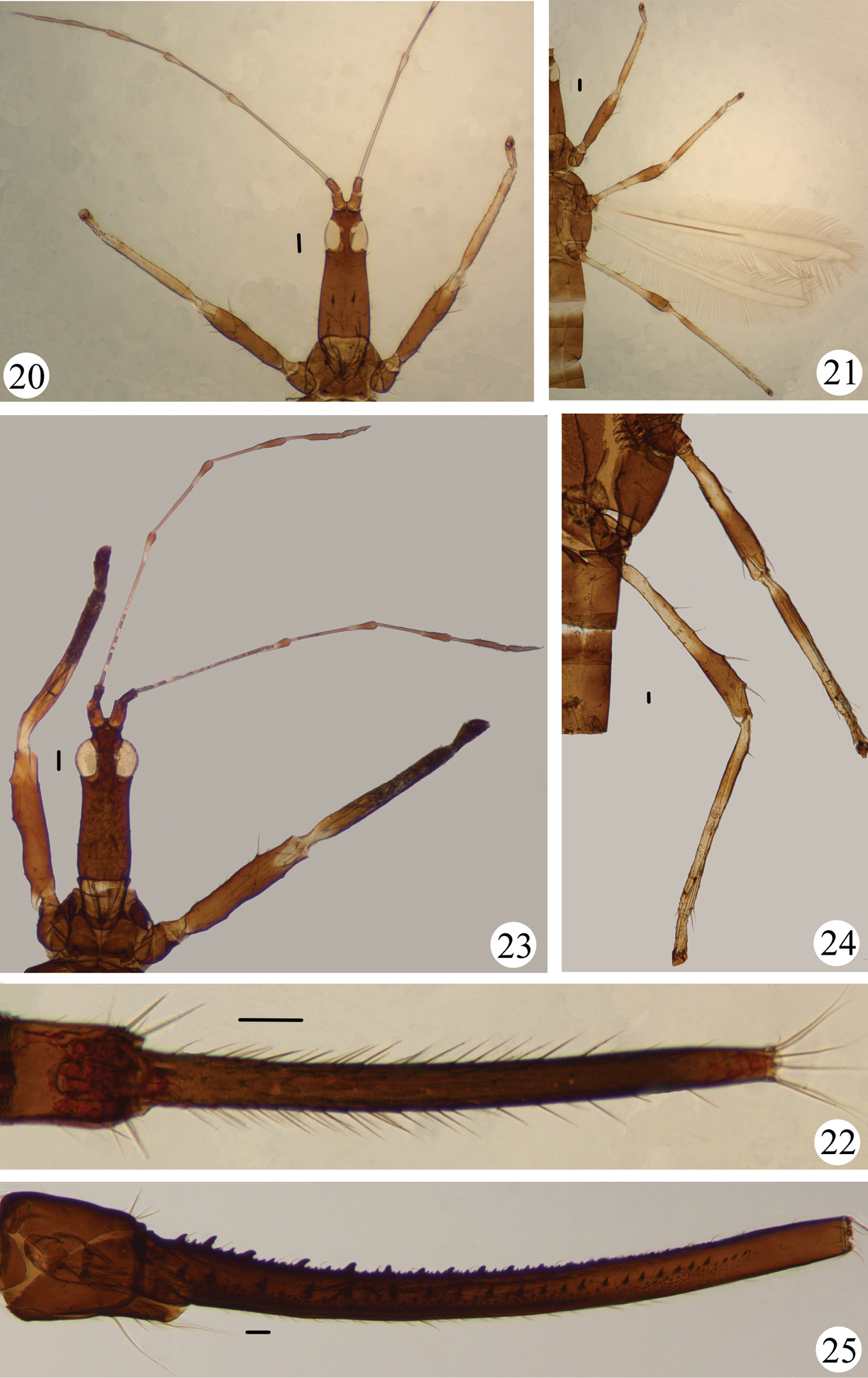






(C) 2012 Li-Hong Dang. This is an open access article distributed under the terms of the Creative Commons Attribution License 3.0 (CC-BY), which permits unrestricted use, distribution, and reproduction in any medium, provided the original author and source are credited.
For reference, use of the paginated PDF or printed version of this article is recommended.
The genus Meiothrips Priesneris reviewed, with Meiothrips fuscicrus sp. n., and Meiothrips nepalensis Kudo & Ananthakrishnan recorded and described from China, and a key provided to the five known species. COI sequences of the new species and Meiothrips nepalensis are also provided.
Meiothrips, Thysanoptera, Phlaeothripidae, Idolothripinae, new species, key, China
Meiothrips was erected as a subgenus of Idolothrips with the type-species Meiothrips annulipes
DNA barcoding sequences (COI) are provided here as identifying characters for Meiothrips fuscicrus sp. n., also the newly recorded species Meiothrips nepalensis. We suggest that, if possible, DNA barcoding sequences (COI or other molecular marker) should be provided when a new taxon is described in order to provide an additional method of identification.
Materials and methodsThe samples of thrips were collected into 95% ethanol and stored at -20°C. Total genomic DNA was extracted from single thrips using the method of
The remaining carcass was removed and stored in 10% KOH for several days (usually 4–6 days for the large thrips, about 8–10 mm), then mounted in Canada balsam. Descriptions and pictures are based on permanent slides of specimens using a Leica DM4000B microscope. Measurements and pictures were processed using the Leica Microsystems with Microsoft QWIN (Leica QWin plus). Thrips terminology in this paper generally follows
All specimens including types and vouchers are deposited in the National Zoological Museum of China, Institute of Zoology, Chinese Academy of Sciences, Beijing, China. The following abbreviations are used for pronotal setae: am-anteromarginals, aa-anteroangulars, ml-midlaterals, epim-epimerals, epima-epimeral accessory, pa-posteroangulars, pm-posteromarginals.
http://species-id.net/wiki/Meiothrips
Body large. Head much longer than width across eyes, prolonged in front of eyes, usually shorter than broad except in one species about twice as long as broad; eyes normal or obviously prolonged on ventral surface; interocellar, postocellar, postocular, mid-dorsal and posterior-dorsal setae usually well developed, sometimes small. Maxillary stylets short and far apart. Antennae 8-segmented, very slender; segment III longest, usually more than twice width across eyes; segments III and IV with 2 and 4 sense-cones. Pronotum major setae usually well developed setae, sometimes aa small and epimeral accessory always minute; notopleural sutures incomplete; basantra and ferna present. Mesopraesternum boat-shaped. Metathoracic sternopleural sutures absent. Wings usually fully developed with or without numerous duplicated cilia. All legs normal, femora with several spine-setae. Pelta always broad, lateral lobes broadly joined to median major lobe; abdominal tergites II–VII each with two pairs of sigmoid wing-retaining setae; tergites V–VIII never with lateral tubercles; tube much longer than head, surface with numerous fine setae, sometimes with 2 rows of stout tubercles and many large and small tubercles or denticles on dorsal surface; anal setae much shorter than tube.
China (Zhejiang, Yunnan, Hainan); India, Nepal, Malaysia, Thailand.
The species of Meiothrips are presumed to all feed only on fungal-spores. In the field, Meiothrips natural populations with deposited egg masses have been observed only on newly-dead dry or withered leaves hanging on branches.
This genus is close to Idolothrips and Bactrothrips. The morphological characters of the females, and the head and thorax of males, are similar in the three genera.
| 1 | Eyes posteriorly prolonged on ventral surface; head with a long preocular projection, about 2 times as long as width | Meiothrips kurosawai |
| – | Eyes posteriorly not prolonged on ventral surface (Figs 2, 13, 20, 23); head with shorter preocular projection, shorter than broad | 2 |
| 2 | Forewing without duplicated cilia | Meiothrips annulipes |
| – | Forewing with duplicated cilia | 3 |
| 3 | Antennal segments VI–VII normal, without a short apical, ventral prolongation; postocular setae small, much shorter than postocular cheek setae; tube of male without dorsal tubercles or denticles | Meiothrips menoni |
| – | Antennal segments VI–VII with a short apical, ventral prolongation; postocular setae similar or longer than postocular cheek setae; tube of male with dorsal tubercles or denticles | 3 |
| 4 | Middle and hind femora bicolored, with about basal half yellow and apical half dark brown | Meiothrips nepalensis |
| – | Middle femora uniformly dark brown, hind femora bicolored, with basal 2/3 and extreme distal parts yellow, the rest dark brown | Meiothrips fuscicrus sp. n. |
urn:lsid:zoobank.org:act:06A55A81-94F2-4BD5-A268-FA0753E9709B
http://species-id.net/wiki/Meiothrips_fuscicrus
Figs 1–19Body uniformly dark brown; antennal segments I–II brown, III yellow but shaded in distal and near basal part, IV–V shaded but yellow in distal pedicels 0.3–0.4, VI–VIII brown; fore wings shaded with brown longitudinal band medially in basal half; femora dark brown but about basal 2/3 and extreme distal of hind femora yellow (Figs 7, 16), tarsi, distal half and extreme bases of tibiae yellow; tube dark brown; major setae yellowish.
Head 2.3 times as long as width across eyes, projecting in front of eyes, transversely striate; interocellar setae long, longer than width of one eye, one pair of postocellar setae about 1.7 times as long as diameter of posterior ocellus; eyes developed, about 0.4 of head length, postocular setae and one pair of postocular cheek setae similar with postocellar setae; mid-dorsal setae longest; cheeks with several pairs of minor setae. Maxillary stylets wide apart, retracted into head one fourth way to posterior margin of eyes (Figs 2, 13). Antennal segment III 2.2 times as long as head width across eyes (Figs 1, 13), III with 2 sensoria, IV with 4, V with 2, VI and VII each with one, these sensoria on III and IV about 2.0 times as long as apical width of segment, segments VI–VII with a short apical, ventral prolongation.
Pronotum smooth, anterior margin concave; three pairs of am, one pair almost as long as aa epima much shorter than one third of longest epim (Figs 3, 14); prosternal basantra around the tip of mouth-cone, ferna triangular. Mesopraesternum boat-shaped (Fig. 5). Metanotal median setae well developed, metanotum smooth on anterior third, with weak reticulate sculpture on posterior half (Figs 4, 15); metathoracic sternopleural sutures absent. Fore wings broad, with 42 duplicated cilia.
Pelta with reticulate sculpture slightly longitudinal (Figs 8, 15); abdominal segments VI–VIII without lateral tubercles (Fig. 9); tergite IX setae much shorter than tube; tube about 2.3 times as long as head, weakly constricted near apex, with about 20 pairs of stout tubercles and many small tubercles (Figs 10, 11, 17, 18), laterally with few weak setae. Sternites with irregular transverse row of discal setae, no pore plates.
Measurements (male in microns). Body length 8171. Head, length 787; width across eyes 342; interocellar setae 105, postocellar setae 62, diameter of posterior ocellus 36; postocular setae 63, postocular cheek setae 59; mid-dorsal setae 162. Antennal segments III–VIII length (maximum width), 758 (51), 437 (49), 379 (48), 306 (35), 83 (29), 89 (18), sensoria of segment III length 101. Pronotum length (maximum width) 336 (553); setae length, am 68, aa 67, ml 75, epim 190, epima 26, pa 109, pm 24. Metanotal median setae length 288. Pelta length 191, width 568. Tergite IX setae S1 141, S2 130. Tube length 1876, stout tubercles length 50, anal setae length 337.
Meiothrips fuscicrussp. n. Male. 1 antenna 2 dorsal view of head 3 dorsal view of pronotum 4 dorsal view of mesonotum and metanotum 5 mesopraesterum 6 base of forewing 7 hind leg 8 pelta 9 dorsal view of abdominal tergites VI–VIII 10 abdominal tergite IX and tube 11 lateral view of tube. Female 12 abdominal tergite IX and tube. Scale bars=100 microns.
Meiothrips fuscicrussp. n. Male. 13 antenna, head, pronotum and fore legs 14 dorsal view of pronotum 15 dorsal view of mesonotum, metanotum and pelta 16 mid and hind legs 17 abdominal tergite IX and tube 18 lateral view of tube. Female 19 abdominal tergite IX and tube. Scale bars=100 microns.
Similar to male but larger. Tube smooth with many prominent lateral setae (Figs 12, 19).
Measurements (female in microns). Body length 8864. Head, length 779; width across eyes 344; interocellar setae 102, postocellar setae 64, diameter of posterior ocellus 35; postocular setae 88, postocular cheek setae 77; mid-dorsal setae 134. Antennal segments III–VIII length (maximum width), 748 (47), 444 (52), 367 (48), 292 (41), 94 (31), 98 (27), sensoria of segment III length 90. Pronotum length (maximum width) 304 (546); setae length, am 51, aa 63, ml ?, epim 185, epima 50, pa 142. Metanotum median setae length 304. Pelta length 189, width 667. Tergite IX setae S1 255, S2 320. Tube length 1913, anal setae length 367.
. Holotype male: China, Yunnan province, coll. M.Y. Lin by shaking withered tree leaves, 7.x.2010 (slides No.JM10058-9). Paratypes: 6 females and 1 male, data as for holotype (slides Nos. JM10058-1, JM10058-5, JM10058-7, JM10058-13, JM10058-15, JM10058-16, JM10058-17).
This species is similar to Meiothrips nepalensis in that the tube of males bears about two rows of stout tubercles also many small tubercles. But the new species can be distinguished by the following characters: fore and mid-femora uniformly dark brown, only hind femora bicolored with about basal 2/3 and extreme distal parts yellow (nepalensis: fore femora uniformly dark brown, mid- and hind femora bicolored with about basal half yellow and apical half dark brown), pronotal am and aa setae about 0.3 times as long as epim setae (nepalensis: am and aa minute, much less than 0.3 times as long as epim).
This species name is composed of two Latin words, “fuscus (= brown)” and “crus (= leg)”, based on mid-femora uniformly dark brown.
We received two sequences of the new species, which include 673bp and 647bp with the GenBank numbers JQ411299 and JQ411300, respectively.
http://species-id.net/wiki/Meiothrips_menoni
Figs 20–228 females and 15 males: China, Yunnan Province, coll. Y.F. Han from withered tree leaves, 17–20.xi.1988 (slides Nos. 14214–14222, 14399), and 27.iii–22.iv.1997 (slides Nos. 21026–21033, 22279, 22795–22796, 22443); 1 male: China, Hainan Province, coll. W.Q. Zhang from withered tree leaves, 5.iv.1984.
China (Yunnan, Hainan); India, Thailand, Malaysia.
This species is mainly distributed in South Asia. It was described originally from India by
Meiothrips spp. 20–22 Meiothrips menoni. Male 20 antenna, head, pronotum and fore legs 21 legs 22 abdominal tergite IX and tube 23–25 Meiothrips nepalensis. Male 23 antenna, head, pronotum and fore legs 24 mid- and hind legs 25 abdominal tergite IX and tube. Scale bars=100 microns.
http://species-id.net/wiki/Meiothrips_nepalensis
Figs 23–251 female and 2 males: China, Yunnan province, coll. M.Y. Lin by shaking withered tree leaves, 7.x.2010 (slides numbers, JM10058-4, JM10058-8, JM10058-12).
China (Yunnan); Nepal, Thailand.
It includes 659bp with the GenBank number JQ411298.
This species is known from Nepal (
The authors are grateful to Mound L.A. (CSIRO, Australia) for kindly provided some useful advice, to B.S. Duan for lending the holotype of thrips. And thanks also are due to Y.F. Han, W.Q. Zhang, M.Y. Lin for their collections and F.D. Yang for making slides. The work was supported by the National Science Funds for Distinguished Young Scientists (No. 31025024), National Natural Sciences Foundation of China (Nos. 30830017), National Science Fund for Fostering Talents in Basic Research (No.J0930004), and a grant (No. O529YX5105) from the Key Laboratory of the Zoological Systematics and Evolution of the Chinese Academy of Sciences.


